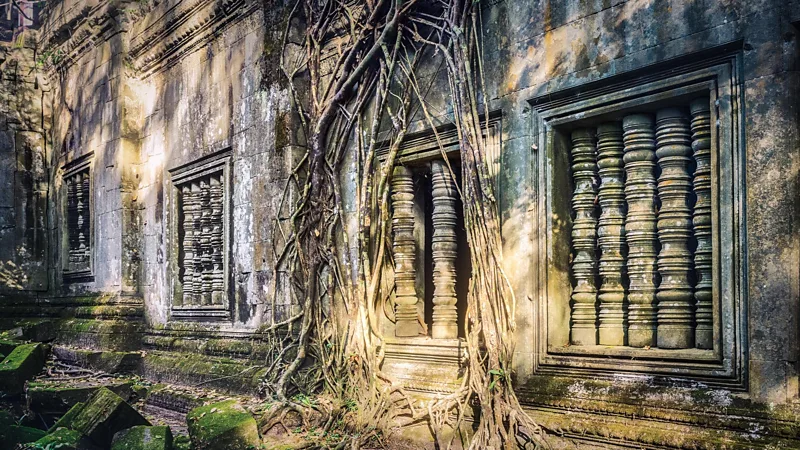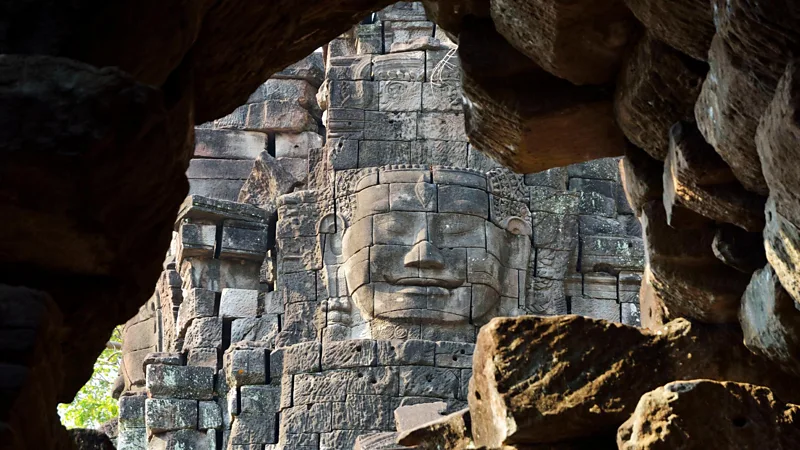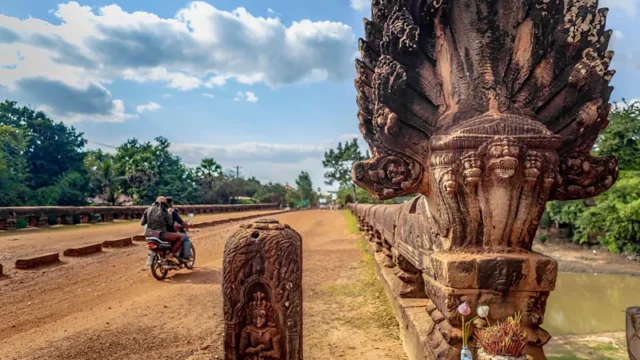Introduction
Cambodia‘s East Royal Road is a 100-kilometer journey into the heart of the Khmer Empire, filled with ancient temples, bridges, and off-road adventures. This route, connecting the renowned Angkor Wat to the lesser-known Beng Mealea and Preah Khan Kompong Svay, offers a unique glimpse into a bygone era. This guide explores a memorable journey along this historic road, uncovering the ancient wonders and challenges of this remote and intriguing path.
The Historic Significance of the East Royal Road
The East Royal Road was an essential artery of the Khmer Empire, which ruled much of Southeast Asia from 802-1431 CE. The Khmer Empire is famed for its temples, but its power also lay in its sophisticated infrastructure, including a 3,000-kilometer road system. This network connected Angkor, the empire’s capital, to the farthest reaches of modern-day Thailand, Vietnam, Laos, and Myanmar.
The East Royal Road is particularly noteworthy for its collection of well-preserved Khmer infrastructure, including bridges, ponds, walls, and embankments. Unique to this road are the resthouse temples, where travelers could find shelter, food, and a place to pray. These temples and the road itself were also crucial in transporting the stones used to construct the empire’s magnificent temples and the iron forged into weaponry.
Setting Out on the Journey
The adventure began early, with a departure from the Raffles Grand Hotel d’Angkor in Siem Reap, reminiscent of Jackie Kennedy’s visit in 1967. The destination was the East Royal Road, a route offering an authentic road trip experience for dirt bikers and temple enthusiasts alike.
The journey’s first stop was Kampong Kdei, an 86-meter-long bridge built during the 12th-century reign of Jayavarman VII, the most ambitious Khmer ruler. This rust-colored bridge, depicted on Cambodia’s 5,000 Riel banknote, features striking balustrades shaped like nine-headed nagas, mythical creatures symbolizing water and fertility in Khmer art.

Exploring Preah Khan: The Empire’s Hidden Gem
The next destination was Preah Khan, one of the empire’s most secluded temples. Unlike the well-trodden Angkor Wat, Preah Khan sees few visitors, offering an almost secretive glimpse into the past. This temple, however, has been heavily looted over the centuries, first by French explorers in the 19th century and later by locals in the 20th century.
Despite the looting, Preah Khan remains a treasure trove of carved three-headed swans, garudas (divine birds), elephants, and nagas. A highlight of the visit was the 9.5-meter-high statue, Preah Chahtomukh, featuring four smiling Buddhas facing each cardinal direction. The serene, enigmatic faces carved into massive stone towers are often referred to as “the Mona Lisas of Southeast Asia.”
The Thrill of Off-Road Adventure
From Preah Khan, the road to the village of Khvav could only be navigated by off-road motorcycles or oxcarts. Fortunately, local guides were available to provide the necessary transportation. The ride on the dirt bike was exhilarating, offering a unique way to experience the rugged Cambodian landscape.
The road from Preah Khan to Beng Mealea is lined with rest stops known as “firehouses” and slightly larger resthouse temples. Historians still debate whether these stops were religious, secular, or served both purposes. Due to their inaccessibility, little research has been conducted on these structures.
A stop at Sopheap Tbong, one of the resthouses, revealed a typical design: an outer wall with a large gate leading to a central hallway flanked by two galleries. These resthouses were strategically placed 15 kilometers apart to accommodate travelers who could cover an average of 30 kilometers per day.

The Remote Ruins of Prasat Pram and Prasat Ta En
Prasat Pram, another resthouse along the route, is now mostly a collection of vine-covered rocks. However, a detached window still reveals the carved pillars that once served as Khmer window blinds. The ruins of Prasat Ta En, a fire shrine, offer a peaceful respite from the journey, with the surrounding trees creating a tranquil atmosphere.
The final bridge on the route, Spean Ta Ong, provided a welcome break from the rugged roads. This ornately carved bridge, over 70 meters long, is adorned with naga balustrades that glow a warm burnt sienna in the late afternoon light.
Beng Mealea: The Mysterious Temple
The adventure concluded at Beng Mealea, a temple constructed around the same time as Angkor Wat. Some believe Beng Mealea served as a prototype for the capital. The temple is shrouded in mystery and romance, with silk cotton trees entwining the stone ruins and strangler figs appearing to claw their way into the earth.
The temple grounds are scattered with large piles of sandstone blocks, many decorated with intricate carvings. Winding wooden walkways lead visitors through the ruins, originally built for the set of the 2004 film Two Brothers. Among the highlights is a moss-covered masterpiece depicting the Churning of the Ocean of Milk, a Hindu legend symbolizing the eternal struggle between good and evil.

Conclusion
The journey along Cambodia’s East Royal Road offers a unique glimpse into the Khmer Empire’s history, far removed from the more popular tourist destinations. From ancient bridges and temples to off-road adventures and hidden ruins, this route provides an unforgettable experience for those willing to venture off the beaten path. As interest in these sites grows, especially with the nomination of Beng Mealea and Preah Khan for UNESCO World Heritage status, now is the perfect time to explore these hidden gems before they become more widely known.











